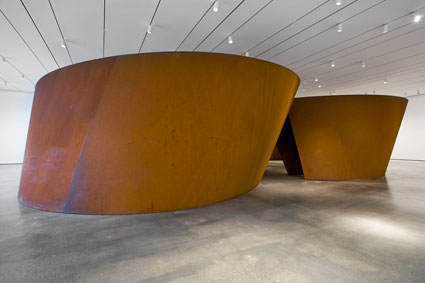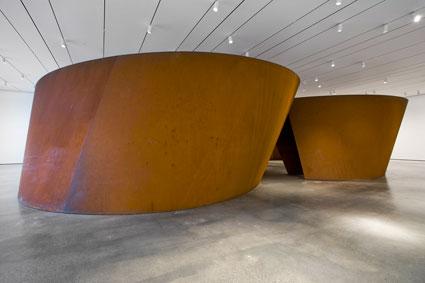Sometimes the public interacts with a piece of art in an unexpected way. Such is the case with Richard Serra’s sculpture Sequence, which sits in one of BCAM’s first-floor galleries. Faced with two rust-colored behemoth pods and a small dark opening, visitors bravely enter and exit (usually smiling) and, as if by revelation, say the most endearing things about a piece of art.

Richard Serra, "Sequence," 2006, lent by the artist
Sequence encloses the spectator and offers a trail, a journey in which time is condensed and expectations are slightly disturbed for some, while others enter aimlessly and come out surprisingly pleased, as if a small, somewhat imperceptible gift had been bestowed upon them. Out of curiosity while on this post over many hours, I would ask them as they were preparing to leave the building how the artwork made them feel. Having seen and heard all matter of emotional response, these are some of their replies.
“That was exquisite!”
“Very unusual, I didn’t expect that.”
“It made me dizzy.”
“That was fun!”
“Thank you so much. That was neat.”
“My kids want to go again.”
“Totally didn’t expect that.”
“I loved the way the walls made you want to lean away or toward them.”
“It’s interesting.”
“But what was the point?”
“That was great!”
“It was cool.”
“I thought it was scary, I’m claustrophobic.”
“I thought it would never end!”
One visitor said that Serra was invoking nature, for on the inside he was in Arizona, and that this mountain of iron made something more of nature. He called it sublime. Sequence is possibly a skin on space if Serra’s words are anything to go by: “not an object we inspect but an arrangement of space in which we move”; “not figures on pedestals.” In John Rajchman’s essay in the book Richard Serra’s Sculpture: 40 Years, he finds Serra talking of a sense of indeterminacy and a “gigantic exercise in thinking.” While watching and listening to the visitors of this heroic piece of art, one witnesses that some of the greatest artists sense the yet-unexplored terrain and guide us there.
Hylan Booker, Gallery Attendant



